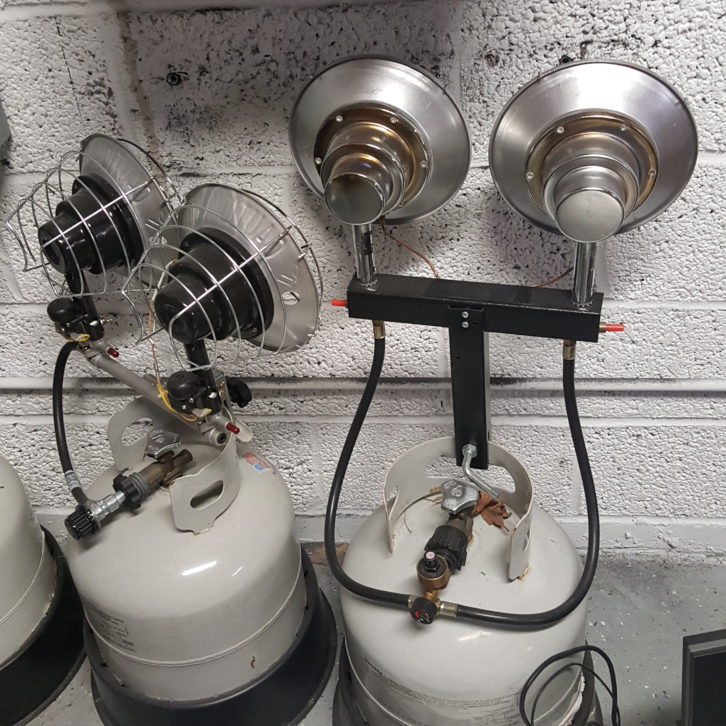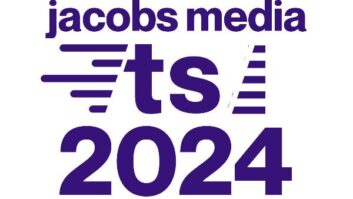For many readers, cold weather will be here before we know it; and that is inevitably when we find ourselves working outside around a tower. (Troubleshooting an AM antenna tuning unit after midnight comes to mind.)
Fig. 1 shows a really neat portable propane heat lamp to keep you warm outside this winter.

Cumulus Regional Engineer Justin “J.T.” Tucker found these dual propane tank-mounted heaters at a camping supply store; they are also available online. Search “portable tank-mount propane heater.”
Single units are under $50, the dual element versions pictured are around $100.
Remember, even though they are equipped with a safety shut-off valve and tip-over switch, do not use these inside your transmitter building or any enclosed spaces.
Useful Videos
We received a nice note from David Mathews, who created the “Moseley 6000 Series Frequency Change” video on YouTube that we described in July. Even if you don’t have to change frequencies on that pair of STLs, David offers a number of useful tips should you ever need to get inside the boxes.
In his note, David reports a lot of “likes,” so thank you, readers!
David tells us that he’s a “sort of” retired assistant chief engineer with North American Broadcasting in Columbus. He plans on putting together future videos on other equipment.
Okay, Workbench readers: Any specific boxes you’d like to learn more about? And for the more seasoned engineers, here’s a challenge to share your knowledge with others using YouTube. If you put something together, let me know.
Swag
Workbench contributor Marc Mann writes in to thank us for letting readers know about Inovonics and their really useful Radio Hero Swag Bag. The secret’s out; Fig. 2 shows what Marc received.

If you missed the offer, there are still a few left. To request one drop an email to [email protected].
MOVs and GDTs
Steven Karty saw the suggestion we shared from Paul Sagi to change out gas discharge tubes with metal oxide varistors inside your surge protection devices.
Steven reminds us to weigh the application and the equipment before making a wholesale change; although MOVs do respond more quickly than GDTs, the much higher capacitance of MOVs limits their use, especially on audio circuits.
There’s no problem if loading up the lines being protected with lots of capacitors connected to ground doesn’t degrade the signal. But many signals will be adversely affected by the extra capacitance, so MOVs are mainly used where the capacitance isn’t a problem, like inside AC powerline surge protection devices, as Paul suggested.
Because MOVs and GDTs wear out with use, Steven suggests they be replaced periodically for continued protection. The failure mode of most MOVs is shorting and (if there’s sufficient power available) melting. Although some GDTs may short, the failure mode of most GDTs is that their firing voltage increases, so that they aren’t providing any protection.
Thanks, Steven. All good points to consider.
Gas discharge tubes are sealed devices with a gas mixture between two electrodes. When a high voltage surge is detected, the gas ionizes, providing a short circuit to ground for the surge.
The metal oxide varistor performs a similar function. The resistance of the MOV changes with voltage, becoming a short circuit when a voltage surge is detected.
Both are shunt devices, “shunting” the high-voltage transient to ground, and hopefully protecting the circuit to which it is connected.
GDT Memories
In addition to surge protectors, GDTs were used in several RCA transmitters to prevent surges from damaging components.
Tucked out of the way, this little glass tube, about the size of your finger, could sometimes short to ground, depending on the intensity of the surge. The resulting permanent short circuit certainly protected the transmitter, but also meant it would not run.
Kudos to RCA design engineers (Buc Fitch?) who mounted the GDT on a snap-in bracket so (like a fuse) it could be pulled out of the circuit and easily replaced. If you have one of these older transmitters, look for it; I’ve seen instances where some engineers would remove the shorted GDT, leaving no protection.
This only invites more damage, should another surge come along.
Put It in the Dryer …
Louis Bornwasser, now retired, was an FM chief engineer in the 1960s and ’70s. Later in his career he serviced and manufactured equipment for motion picture theaters, “in the days before digital.”
Louis writes to tell us that he has cleaned power cords, mic cords and air and garden hoses for 40 years using the kitchen dishwasher, though he admits that the idea we shared recently would not have occurred to him, though circuit board cleaners that he used in the manufacturing process are similar.
Louis adds: Do it without dishes.
… Or Put It in the Wash
Louis brings up a good point. Although I’ve never personally done it, I have heard stories of engineers using a car wash to clean an old transmitter before moving it to a new location or frequency.
One fellow laid the transmitter in the bed of his truck and took it through. Then, he turned the transmitter over and repeated the process. He told me he supported the transmitter on a few 4×4 blocks of wood, allowing the water to drain. He removed things like doors and relays and tubes, but it apparently worked.
Another took the transmitter to a do-it-yourself car wash. Using the hand-held spray nozzle, he could reach into all the nooks and crannies to get years of grime out. I’m hoping that one or more of our readers who have done this can write in, and maybe include a picture or two.
My concern would be things like transformers, especially the high-voltage type! That’s the last thing you want to compromise with water and soap! Leaving the equipment to dry in the sun for a week is probably “good engineering practice.”
John Bisset has spent over 50 years in the broadcasting industry and is still learning. He handles western U.S. radio sales for the Telos Alliance. He holds CPBE certification with the Society of Broadcast Engineers and is a past recipient of the SBE’s Educator of the Year Award. Workbench submissions are encouraged, qualify for SBE Recertification, and can be emailed to [email protected].












